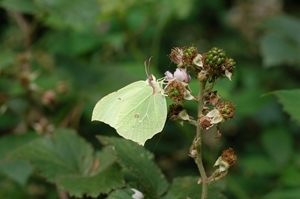Brimstone
 So who put the “butter” in butterfly? “I did,” said the male brimstone – “it was me!”
So who put the “butter” in butterfly? “I did,” said the male brimstone – “it was me!”
Yes, it is commonly believed that the word butterfly is a derived from “butter-coloured fly” which is attributed to the sulphur yellow of the male brimstone butterfly, the female being a much paler whitish-green. Brimstone is an old-fashioned name for sulphur and was as we all know referred to in the Bible as “fire and brimstone” (burn stone).
It is highly likely that the first butterfly you’ll see each year will be a male brimstone, who takes any opportunity of the first warm, sunny spell to leave his wintering quarters to see if he can find a female to mate with or a little nectar from a newly opened flower. Should he come across a newly-emerged female while out scouting, she will almost certainly not agree to mate straight away but instead she will fly almost vertically upwards, sometimes as high as 20 metres or so, hotly pursued by the male! It is a wonderful spring dance to witness!
The brimstone over-winters as an adult butterfly, very often choosing ivy (sometimes bramble too) to hibernate within. They hang upside down within the ivy and look almost identical to a leaf that is dying off – both in shape and colour – a wonderful ploy to avoid being eaten by hungry birds!
You can actually see this “butter-fly” in any month of the year, although the peak time is in April and May and again in August when the offspring reach adulthood. The brimstone therefore remains as an adult butterfly longer than any of our native species, emerging from the chrysalis in July and living right the way through to the following summer.
The distribution of this species closely follows that of the caterpillar’s food plant, buckthorn, which occurs mainly on calcareous soils, or alder buckthorn, which is found mainly on the more moist acidic soils. In England, brimstones can generally be found south of a line from Cheshire in the west to southern Yorkshire in the east, although the species has been moving slowly northwards of late, perhaps as a result of climate change. In fact, data from the Butterfly Conservation National Garden Butterfly Survey shows that the percentage of gardens visited by brimstone has steadily increased in counties from Derbyshire north to the Scottish border.
In 1998 the Suffolk branch of Butterfly Conservation joined forces with other local conservation groups and launched the Brimstones and Buckthorn initiative. Essentially, it was a wildlife gardening exercise to encourage people to plant buckthorn bushes, as there were very few growing locally. The initiative was a great success and in just two years over 2,000 buckthorn bushes were planted in the target area. Female brimstones often range widely in search of buckthorn and soon started to home in on the newly planted bushes, intent on laying their eggs.
Bushes continued to be planted for three more years until 2003, with the result that butterflies were increasingly seen in the area. For example, from 2000 to 2004 there were 242 records of brimstones in East Suffolk, rising to 644 from 2005 to 2009.
Brimstone butterflies have very long proboscis, enabling them to exploit deep down into flowers that many other butterflies struggle to access, such as runner bean flowers, teasel, cowslip and bluebell.
So if you want to encourage this beautiful butterfly into your garden or onto the farm, leave some ivy in place for them to over-winter in, plant some buckthorn bushes and perhaps a few teasels, and sit back and wait for them to appear, as they most surely will!
Peter Thompson
Advisory
Read more from Peter Thompson at the Fresh from the Field blog.

Download Peter Thompson's essential 26-page book, featuring beautiful photography and detailed profiles of Britain's wildlife
Download FREE >